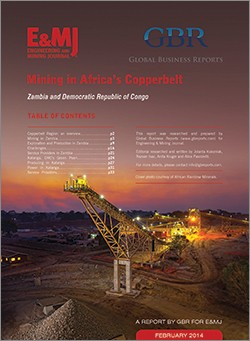
PUBLICATION
Copperbelt Mining 2014 E&MJ Release
The area that has become known as the Copperbelt, and which stretches across Central Africa traversing Zambia and the province of Katanga in the Democratic Republic of Congo (DRC), extends for about 280 miles and is 160 miles in width and is thought to contain one tenth of the world’s copper deposits, mostly in Late Precambrian sedimentary deposits. Copper mining became the financial backbone of what was the Belgium Congo (today DRC) and Northern Rhodesia (now Zambia) when the Copperbelt acquired its name. After the painful and disrupting political vacillations following independence in each country, which saw the industry falter amidst mismanagement and a lack of investment, Zambia and DRC are now both once again listed amongst the world’s top ten leading copper producing countries.
Production volumes are increasing rapidly and investors are piling in from Canada to China. Political stability in Zambia and in Katanga Province, the area of the DRC where the majority of copper is found, together with largely proactive and business friendly governments have renewed interest in the area which is currently home to a boom
in investments.
Infrastructure and skill, however, lag behind the pace of industrial progress and massive efforts in both of these areas are required for these countries to reach their potential.
The following report examines the current state of the mining industry in these two countries that together form the Copperbelt and discusses the challenges of doing business in each.







